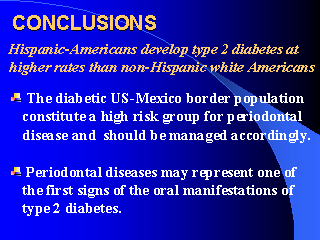|
|
|
|
front |1 |2 |3 |4 |5 |6 |7 |8 |9 |10 |11 |12 |13 |14 |15 |16 |17 |18 |19 |20 |21 |22 |23 |24 |25 |26 |27 |28 |29 |30 |31 |32 |33 |34 |review |
 |
In summary, the oral cavity represents a unique environment where the host is
continuously defending against microbial infection. Evidence suggests that the
host's immune system plays a critical role in preventing microbial colonization
of these tissues. It is well recognized that the development of periodontal
disease depends upon the interaction between the oral anaerobic microbes found
in the crevicular space/dental plaque and the host response. Since diabetes can
cause a decrease in the host's defense mechanisms, an increase frequency and
severity of periodontal disease in Type 2 DM individuals is not unexpected.
The importance of diagnosing the oral manifestations of Type 2 DM is twofold:
Moreover, the literature suggests that the oral manifestations of Type 2 DM are frequently seen before the actual diagnosis of diabetes occurs as evidenced by the greater number of investigations. Periodontal disease, a major oral manifestation of Type 2 DM, is a progressive, at times painful, and locally destructive disease. Conventional periodontal treatment has proven to have only limited success in controlling this destructive disease. Yet, on the other hand, proper diagnosis and the concomitant appropriate therapy have been shown to be highly effective in controlling not only Type 2 DM but also the oral manifestations of Type 2 DM. Therefore, the early identification of the oral manifestations associated with Type 2 DM, including diabetes, is a particularly important role for the dental public health professional. Clearly, knowledge of the risks factors for periodontitis is critical if the dental public health professional is to focus further preventive and treatment regimens on the Type 2 DM patient population. However, the review of the literature has demonstrate, thus far, that periodontal disease is not a specific disease entity but rather the result of local irritation, inflammation and infection in the presence of decreased systemic resistance and the prevailing opinion is that diabetes is a predisposing factor that reduces the resistance of the periodontal tissues to microbial activity. |